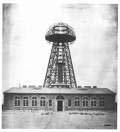 TOWER
TOWERTESLA  TOWER
TOWER
(performance duration @ 10 minutes) (see below for full instrumentation)
© 1999 Anthony G. Holland
About the composition (notes from the composer):
I first saw the name “Tesla” as a “brand” name on the television and radio sets in Eastern Europe. My curiosity up, I began to research the name and was astounded to learn that Nikola Tesla is considered by many to be history’s greatest inventive genius. As far back as the 1890’s, while still a young man, Tesla conceived, patented, built and tested devices which were so far ahead of their time that some of them are still classified “TOP SECRET” by the U.S. Government today! The list of his inventions is astounding and includes: radio (the U.S. Supreme Court ruled years after Tesla’s death that Marconi had stolen the design), lasers (Tesla successfully bounced lasers off the moon in the 1920’s), radio remote control, particle beam weapons, the famous “Tesla Coil”, and neon and florescent lights (General Electric Corporation held the patents for nearly 50 years before commercially releasing them). All of the world’s transmission of electrical power today is due to Tesla. It was Tesla’s wizadry which allowed for the very first construction of hydro-electric power generators in Buffalo, New York, where a statue in his honor still stands today. Why Tesla’s name is not generally known today is a story of peer jealousy, treachery, and corporate greed, but perhaps the most astounding of his inventions would have been his tower which he had built on Long Island, known officially as the “Wardenclyffe Tower”. It was a full-scale working model of an experiment he had built and successfully executed in Colorado Springs only a few years earlier. The “TESLA TOWER” was designed to beam electrical energy and ‘intelligence’ (communication) throughout the globe without the need for electrical wires. Further, Tesla intended to give away electrical power, free of charge, to the world, by beaming that power from a series of his towers constructed around the world. Just before the final stages of the construction of the tower were complete, Tesla’s backers, America’s most wealthy corporate leaders, pulled out their financial backing. Tesla’s greatest invention was never to be tested or realized. He never fully recovered from that great setback.
This composition, the TESLA TOWER, is my compositional reaction to the idea of “What if” Tesla’s Tower had been completed? What would it have been like to be there for the unveiling of the century’s most sophisticated invention and an invention from which all of humanity would have benefited? Tesla’s humanist dream may have been realized on that day and I believe a new day would have dawned which would have changed the remainder of the history of the 20th Century.
For the first time listener of this piece, I hope you will feel the atmosphere of excitement and even the foreboding as Tesla’s Tower is first unveiled. A passage where the brass are first heard without mutes is meant to describe the splendor and majesty of the mighty tower. Then notice the recurring rhythms that invoke the type of communication that Tesla’s Tower may have transmitted. The rhythms are added atop each other, building in intensity, and as the complex mass of polyrhythms and complex stacked vertical sonorities reach their zenith, the brass enter, stacking from bottom to top and playing a harmony which announces the “dawning of a new day”. One rhythm, which occurs repeatedly throughout the piece in different modes, even spells out the name “T-E-S-L-A”, and it is this rhythm with which the entire composition draws to a dramatic end.
INSTRUMENTATION:
PICCOLO, 2 FLUTES, 2 OBOES, Eb SOPRANO CLARINET, 3 Bb CLARINETS, Eb ALTO CLARINET, Bb BASS CLARINET, Eb CONTRAALTO CLARINET, 2 BASSOONS, CONTRABASSOON, ALTO SAXOPHONE 1&2, TENOR SAXOPHONE, BARITONE SAXOPHONE, FRENCH HORNS 1-4, Bb TRUMPETS 1-6, TROMBONES 1-4 (4th with F Trigger), EUPHONIUM, TUBA, 5 PERCUSSION PLAYERS, PIANO, CELESTA, HARP, DOUBLE BASS